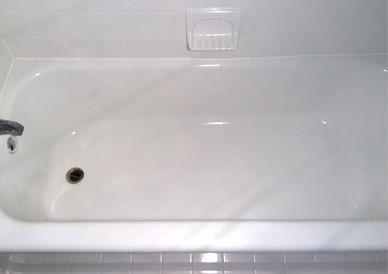Q. We are considering an epoxy (or similar) refinish to an old cast iron tub (cannot be removed). Are there health risks of chemicals leaching from the epoxy finish during hot baths or baths with Epsom salts?
A.When it comes to bathtub refinishing, most of the danger lies in the process itself, so unless you’re planning to tackle DIY bathtub refinishing – which most experts advise against – you’ll be safe.
EPOXY COATING RELEASES DANGEROUS VAPORS
The first step in bathtub refinishing requires workers to strip off the old finish, and the stripping agents contain harmful chemicals that emit volatile organic compounds, which can be extremely dangerous in a small, enclosed bathroom with little or no ventilation.
Epoxy coating also releases vapors from isocyanates when sprayed, so stay away from the area. Isocyanates include compounds classified as potential human carcinogens, according to the U.S. Department of Labor. Experts recommend occupants leave the home during the spraying process and while the coat is curing as a safety precaution.
Once the epoxy coat cures – usually 36 to 48 hours later – you’re in the clear. Be sure to follow the timeline given to you by your bathtub refinishing contractor to avoid any potential harm.

A word of caution about epoxy: some contractors say they don’t use this material due to the potential health risks when spraying and severe deficiencies in long-term appearance. While Epsom salts won’t cause chemicals in an epoxy tub to leach, keep in mind the salt is abrasive and can cause the finish to deteriorate more quickly.
TRY AN ALTERNATIVE OPTION FOR BATHTUB REFINISHING
Other options exist that pose less risk. The industry has made strides in reducing the use of chemicals in bathtub refinishing over the last few years.
Some bathtub refinishers scrape and sand old finish from bathtubs to avoid using methylene chloride. Methylene chloride is the chemical found in most stripping agents and has caused the death of at least 14 workers since 2000, according to the Occupational Safety & Health Administration. Unfortunately, the scraping and sanding process for tub refinishing is still new, so it’s not yet a widespread practice.
Instead of chemical-filled epoxy finishes, some companies now offer polymer finish as a green alternative. Advanced polymer is free from isocyanates, so it poses less of a risk to consumers and workers applying the finish.
Some companies also offer acrylic urethane finish. This can be hit or miss, as some acrylics also contain isocyanates and require a 48-hour curing period, during which the home’s occupants should stay away. However, there are also acrylics that don’t contain isocyanates, though those cost more.
Fortunately, there’s not much of a cost difference between the different bathtub finishes. Epoxy, regular acrylic urethane and polymer bathtub refinishing projects typically cost between $200 and $500. Choosing an isocyanate-free acrylic urethane can increase the cost by a few hundred dollars.
When hiring, be sure to search for companies that have positive reviews on a trusted consumer site, and can provide proof of appropriate licensing, insurance and bonding.